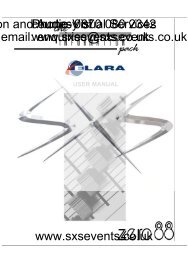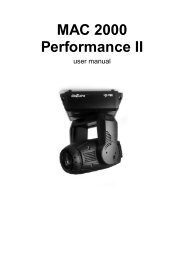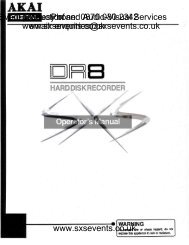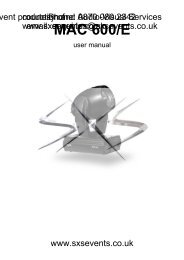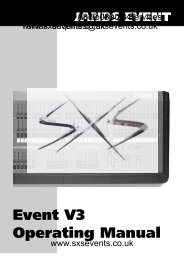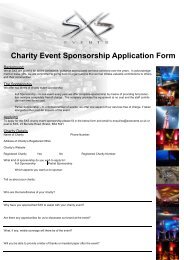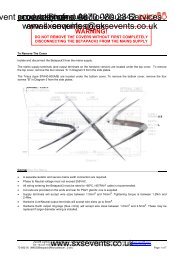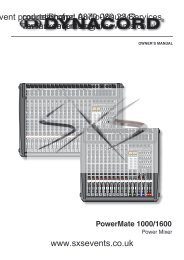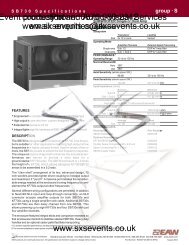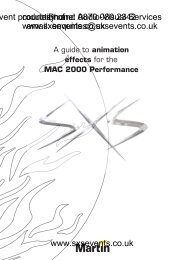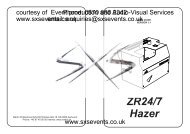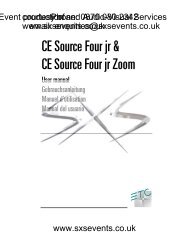Rigging - CM Lodestar Manual - SXS Events
Rigging - CM Lodestar Manual - SXS Events
Rigging - CM Lodestar Manual - SXS Events
You also want an ePaper? Increase the reach of your titles
YUMPU automatically turns print PDFs into web optimized ePapers that Google loves.
vent courtesy production Phone: of and 0870 Audio-Visual 080 “A” 2342Services<br />
LATCH (Upper and TYPE Lower)<br />
HOOK<br />
TO<br />
DEPRESS MEASURE LATCH OPENING,<br />
HOOK BODY AS SHOWN.<br />
AGAINST<br />
MEASURE<br />
OPENING<br />
LATCHLOCK ® TYPE HOOK<br />
(UPPER AND LOWER)<br />
www.sxsevents.co.uk<br />
email: enquiries@sxsevents.co.uk<br />
“B” Max.<br />
Models<br />
Replace Hooks<br />
When Opening<br />
is Greater<br />
Than<br />
B, C AND F 1 3/16 (30.2mm)<br />
J, L, AND LL 1 5/16 (33.3mm)<br />
R AND RR<br />
1 1/2 (38.1mm)<br />
Models<br />
B, C, F, J, L, AND LL<br />
R AND RR<br />
Replace Hook<br />
When Opening<br />
or Seat are:<br />
“A” Max<br />
1 31/64 in.<br />
(37.7mm)<br />
1 59/64 in.<br />
(48.8mm)<br />
“B” Max<br />
2 1/32 in.<br />
(51.6mm)<br />
27/32 in.<br />
(21.4mm)<br />
Figure 14. Hook Inspection<br />
LOAD CHAIN<br />
Chain should feed smoothly into and away from the hoist or<br />
hook block. If chain binds, jumps or is noisy, first clean and<br />
lubricate it (see below). If trouble persists, inspect chain and<br />
mating parts for wear, distortion or other damage.<br />
Chain Inspection<br />
First Clean chain with a non-caustic/non-acid type solvent and<br />
make a link by link inspection for nicks, gouges, twisted links,<br />
weld splatter, corrosion pits, striations (minute parallel lines),<br />
cracks in weld areas, wear and stretching. Chain with any one<br />
of these defects must be replaced.<br />
Slack the portion if the chain that normally passes over the liftwheel.<br />
Examine the interlink area for the point of maximum<br />
wear (polishing, see Figure 15). Measure and record the stock<br />
diameter at this point of the link. Then measure stock diameter<br />
in the same area on a link that does not pass over the liftwheel<br />
(use the link adjacent to the loose end link for this purpose).<br />
compare these two measurements. If the stock diameter of the<br />
worn link is 0.010 inches (0.254 mm), or more, less than the<br />
stock diameter of the unworn link, the chain must be replace.<br />
Figure 16. Chain Inspection<br />
Note that worn chain can be an indication of worn hoist components.<br />
For this reason, the hoist’s chain guide, hook block<br />
and liftwheel should be examined for wear and replaced as<br />
necessary when replacing worn chain.<br />
Also, these chains are specially heat treated and hardened<br />
and should never be repaired.<br />
Figure 17. Chain Embossing<br />
Use only Star (*) grade load chain and original replacement<br />
parts. Use of other chain and parts may be dangerous and<br />
voids factory warranty.<br />
Figure 15. Chain Wear Areas<br />
On double reeved units, repeat this examination of the chain<br />
that passes through the hook block.<br />
Also check chain for stretch using a vernier caliper as shown<br />
in Figure 16. Select an unused, unstretched section of chain<br />
(usually at the lose end) and measure and record the length<br />
over 11 chain links (pitches). Measure and record the same<br />
length on a worn section of the chain. Obtain the amount of<br />
stretch and wear by subtracting the measurement of the worn<br />
section. If the result (amount of stretch and wear) is greater<br />
than 0.145 inch (3.7mm), the chain must be replaced.<br />
Use only a “Knife-edge” caliper to eliminate possibility of false<br />
reading by not measuring full pitch length.<br />
V!<br />
www.sxsevents.co.uk<br />
WARNING<br />
Use of commerical or other manufactures’ chain and parts<br />
to repair <strong>Lodestar</strong> Hoists may cause load loss.<br />
TO AVOID INJURY:<br />
Use only factory supplied replacement load chain and parts.<br />
Chain and parts may look alike, but factory original chain<br />
and parts are made of specific materials or processed to<br />
achieve specific properties. See Figure 17.<br />
IMPORTANT: Do not use replaced chain for other purposes<br />
such as lifting or pulling. Load chain may break suddenly<br />
without visual deformation. For this reason, cut replaced<br />
chain into short lengths to prevent use after disposal.<br />
10



